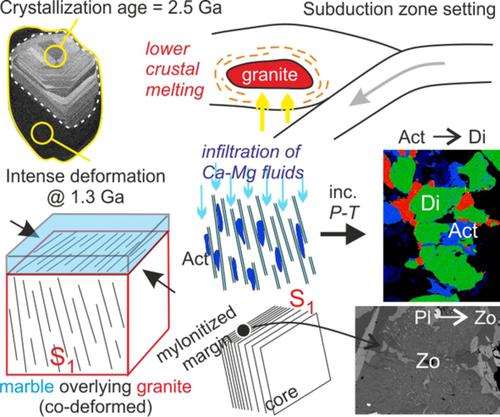当前位置:
X-MOL 学术
›
Geolog. J.
›
论文详情
Our official English website, www.x-mol.net, welcomes your feedback! (Note: you will need to create a separate account there.)
Neoarchaean crustal reworking in the Aravalli Craton: Petrogenesis and tectonometamorphic history of the Malola granite, Bhilwara area, northwestern India
Geological Journal ( IF 1.8 ) Pub Date : 2020-08-03 , DOI: 10.1002/gj.3927 Joseph D'Souza 1 , Hetu Sheth 1 , Yigang Xu 2 , Wencke Wegner 3, 4 , N. Prabhakar 1 , Kamal Kant Sharma 5 , Christian Koeberl 3, 4
Geological Journal ( IF 1.8 ) Pub Date : 2020-08-03 , DOI: 10.1002/gj.3927 Joseph D'Souza 1 , Hetu Sheth 1 , Yigang Xu 2 , Wencke Wegner 3, 4 , N. Prabhakar 1 , Kamal Kant Sharma 5 , Christian Koeberl 3, 4
Affiliation

|
The Banded Gneissic Complex of the Aravalli Craton of northwestern India comprises Palaeo‐ to Neoarchaean (3.3–2.7 Ga) gneisses, including tonalite–trondhjemite–granodiorite (TTG) gneisses, intruded by Neoarchaean (2.6–2.5 Ga) TTGs, sanukitoids, and potassic granites. The latter include the Malola granite that crops out near Bhilwara and forms the basement for the Mesoproterozoic Pur‐Banera mineralized belt. The granite has experienced three deformation events, represented by an S1 foliation and superimposed open folds and dextral shears. Textural evidence and thermobarometry indicate that prograde metamorphism initially forming actinolite and subsequently diopside, and culminating in the upper amphibolite facies, was followed by retrograde metamorphism in the greenschist facies with fluid influx, forming zoisite. Zircon geochronology yields a crystallization age of 2,538 ± 11 Ma and indicates a prominent metamorphic overprint in the region at 1,307 ± 9 Ma. The Malola granite has low Sr–Nd isotopic ratios, enrichments in fluid‐mobile elements (Cs, Rb, Ba, Th, and Pb), and depletions in alteration‐resistant elements (Nb, Ta, and Ti). These characteristics combined with mineralogical evidence suggest that the granite was derived by anatexis of older crystalline crust (possibly granulitic lower crust) in the same subduction zone setting inferred previously for other Neoarchean granitoids in this region. Geochemical and Sr–Nd–Hf isotopic similarities between the Malola granite and Neoarchaean granitoids of the Aravalli, Bundelkhand, Bastar, Dharwar, and Congo cratons indicate a major role for anatectic crustal reworking in their genesis.
中文翻译:

Aravalli Craton的新古地壳重工:印度西北部Bhilwara地区Malola花岗岩的岩石成因和构造变形史
印度西北部Aravalli Craton的带状片麻岩复合体包括古隆起至新古宙(3.3-2.7 Ga)片麻岩,其中包括斜长石-长白云母-碎屑闪长岩(TTG)片麻岩,这些岩片被新古宙(2.6-2.5 Ga)TTG,sanukitoids和钾肥侵入花岗岩。后者包括在Bhilwara附近长出的Malola花岗岩,形成了中元古界Pur-Banera矿化带的基底。花岗岩经历了三个变形事件,以S 1表示叶和重叠的褶皱和右旋剪切。纹理证据和热压法表明,渐进变质作用最初形成阳起石,然后透辉石,最后在上层角闪岩相中达到顶峰,随后在绿片岩相中发生逆向变质作用,并有流体大量涌入,形成了膨润土。锆石年代学产生的结晶年龄为2538±11 Ma,并表明该区域1307±9 Ma处有明显的变质叠印。Malola花岗岩具有低的Sr-Nd同位素比,可流动的元素(Cs,Rb,Ba,Th和Pb)富集,以及抗蚀变元素(Nb,Ta和Ti)贫乏。这些特征与矿物学证据相结合,表明该花岗岩是由较早的结晶地壳(可能是粒状下地壳)的厌食物在相同的俯冲带中推断出来的,而该俯冲带的位置先前已推断出该地区的其他新古纪花岗岩。阿罗瓦利,班德尔坎德,巴斯塔,达瓦尔和刚果克拉通的Malola花岗岩和新古生代花岗岩之间的地球化学和Sr-Nd-Hf同位素相似性表明,成矿质地壳返修在其成因中起着重要作用。
更新日期:2020-08-03
中文翻译:

Aravalli Craton的新古地壳重工:印度西北部Bhilwara地区Malola花岗岩的岩石成因和构造变形史
印度西北部Aravalli Craton的带状片麻岩复合体包括古隆起至新古宙(3.3-2.7 Ga)片麻岩,其中包括斜长石-长白云母-碎屑闪长岩(TTG)片麻岩,这些岩片被新古宙(2.6-2.5 Ga)TTG,sanukitoids和钾肥侵入花岗岩。后者包括在Bhilwara附近长出的Malola花岗岩,形成了中元古界Pur-Banera矿化带的基底。花岗岩经历了三个变形事件,以S 1表示叶和重叠的褶皱和右旋剪切。纹理证据和热压法表明,渐进变质作用最初形成阳起石,然后透辉石,最后在上层角闪岩相中达到顶峰,随后在绿片岩相中发生逆向变质作用,并有流体大量涌入,形成了膨润土。锆石年代学产生的结晶年龄为2538±11 Ma,并表明该区域1307±9 Ma处有明显的变质叠印。Malola花岗岩具有低的Sr-Nd同位素比,可流动的元素(Cs,Rb,Ba,Th和Pb)富集,以及抗蚀变元素(Nb,Ta和Ti)贫乏。这些特征与矿物学证据相结合,表明该花岗岩是由较早的结晶地壳(可能是粒状下地壳)的厌食物在相同的俯冲带中推断出来的,而该俯冲带的位置先前已推断出该地区的其他新古纪花岗岩。阿罗瓦利,班德尔坎德,巴斯塔,达瓦尔和刚果克拉通的Malola花岗岩和新古生代花岗岩之间的地球化学和Sr-Nd-Hf同位素相似性表明,成矿质地壳返修在其成因中起着重要作用。



























 京公网安备 11010802027423号
京公网安备 11010802027423号